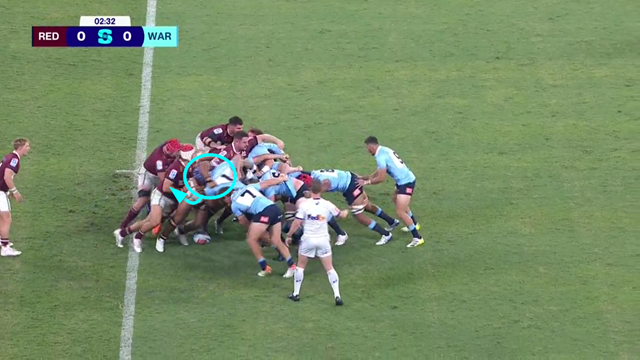Three-time World Cup-winning coach Wayne Smith is not nicknamed ‘The Professor’ for nothing. Without his creative input, a huge proportion of the innovations in the professional game would never have occurred. He is a relentless advocate for positive play and the creation of attacking opportunity through the game’s laws and structures.
Recently he commented that he had switched channels on the telly after watching five yellow cards issued in the match between the Highlanders and the Western Force. He thought he would be better off viewing a nature documentary on the Serengeti instead. Here are his words from the All Blacks podcast:
“I don’t know about you, but I’m getting frustrated with the game.
“Not the players, I’m frustrated with the game.
“I watched the game that Nic Berry refereed the other day, and his arm is out the whole time. Every single play, there’s an advantage.
“I turned off for the first time in my life at halftime. I actually put on program on the lions in the Serengeti. I watched an animal documentary.
“I was so frustrated with it. I don’t know if it got any better in the second half. It probably did. But I just thought it’s not the sort of game I want to watch at the moment when it’s like that.”
One of the issues ‘Smithy’ highlighted was the manipulation of penalties from on-field situations in the middle of the field, in order to kick for the corner and attack from close-range lineout drives. He had first-hand experience of this ploy as head coach of the Black Ferns, who had to offset the Red Roses’ outstanding maul to win a World Cup final back in November.
The Ferns eventually won the game, but they still conceded four tries directly from the lineout drive to a 14-woman England in the process, while scoring two tries of their own from exactly the same tactic https://www.youtube.com/watch?v=hN8yT2_DOAg.
The driving maul has always been a legitimate part of the game, so the solution to the problem Wayne Smith highlights needs to begin at source, with the scenarios which lead to the penalty awards around midfield.
Primary among them is the scrum. There are some very good teams indeed who have worked the scrum for penalties in order to establish their goal-line lineout maul for as long as anyone can remember, like the Brumbies in Australia and Leicester in England.
In this article written over two years ago, I illustrated some of the scrum techniques which back the referee into a corner https://www.therugbysite.com/blog/set-piece/how-to-cure-the-blight-of-scrum-penalties-in-modern-rugby.
According the stats provided by World Rugby, the number of scrum penalties has tripled at World Cups in the professional era (from 10% to 29%) while the amount of clean usable ball produced by the set-piece has dwindled by more than half, from 25 balls per game in the tournaments 1987-1995 to a mere 10 over the last three competitions (2011-2019).
Up until round 10 of the current Super Rugby Pacific competition, 30% of the scrums had ended in either a penalty or a free-kick and that is why vigilant, positive refereeing can make such a big difference, especially when the feeding side tries to rotate around the loose-head corner of the set-piece in order to simulate ‘dominance’ and win a cheap technical penalty.
The early scrums tend to establish the ‘rules’ for the rest of the game. In the recent match between the Queensland Reds and the New South Wales Waratahs, refereed by top-tier international official Angus Gardner, the Waratahs’ loose-head prop (Tetera Faulkner) was allowed to walk around the opposing tight-head (Zane Nongorr) at the first two scrums:

Faulkner starts stepping sideways, out to his left, and his head (in the blue cap) appears underneath the crook of Nongorr’s right elbow. These are the tell-tale signs that he is dragging the scrum around the corner rather than scrumming straight. Angus Gardner called a reset, even though the ball had emerged on the Queensland side and was in the process of being used.
On reset, Gardner awarded a penalty to the Waratahs and that established a platform for Tetera Faulkner’s success in the remainder of the game:
Faulkner’s head appears outside Nongorr’s shoulder early as he steps left, and the NSW prop on the far side is clearly pulling his opponent rather than pushing him, but the pattern has now been set:

The outcome was a sea of slewing, disintegrating scrums, with 40% of the set-pieces resulting in either a reset, or a penalty against the Reds.
The game between the Highlanders and the Hurricanes was also refereed by an Australian, Damon Murphy, but he set very different ground-rules right from the start:
As soon as the head of the feeding team’s loose-head (Ethan de Groot) appears outside his opponent’s right shoulder, Murphy either penalizes him (in the first instance) or calls a reset (in the second). When the young All Black began to debate the issue, Damon Murphy stood firm: “We won’t be arguing about it all game either.”
That meant de Groot had to forget about the walk-around, and keep his head position far closer to his opponent’s sternum. The outcome was a healthy majority of completed scrums: 25 scrums with only 20% ending in a penalty or reset.
Summary
If World Rugby wants to make the game leaner and create more content, with fewer technical penalties and less opportunity to employ the midfield penalty-to-lineout drive matrix, it can start with the scrum. If the referee can put down a marker early in this area, as Damon Murphy did in the match between the Highlanders and Hurricanes, he can gain control of the set-piece, produce more completed scrums and enable the spectacle of the game to flourish. That might even persuade ‘The Professor’ to switch channels, and watch the rugby again.








.jpg)









.jpg)



